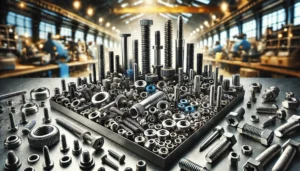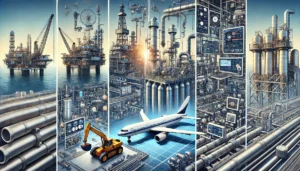The industrial sector has always been one of the most important for a nation’s economic progression as it is responsible for innovation and making available goods and services. However, traditional methods of industry relied upon have always had a strong negative impact on the environment such as high energy use, pollution, and depletion of resources. In order to deal with the deepening environmental issues and regulatory pressures, there has been a joint effort made to design and develop more efficient and sustainable industrial tools that lessen the negative alterations on the environment. These sustainable industrial tools aim at protecting the environment while delivering service or meeting industrial requirements.
1. Constructing Sustainable Industrial Electric Tools
One of the major targets of industrial sustainable tools engineering and development is to counter the emission of greenhouse gas as well as replace fossil fuel dependent systems. The energy efficiency of any country is always under scrutiny and evaluation. Moreover, obsolete industrial machinery and tools are often powered indirectly via fossil fuels which contribute significantly to the carbon emission. Hence, the enhancement and development of these sustainable tools aim for strategic energy use that enables minimization of carbon emissions and consumption of the resources. The sustainable tools to be developed include economic variable speed drives, efficient A.C. motors and automated control systems. These tools are crucial for effective energy management which results in reducing consumption and emission of the gases.
For example, using energy efficient parts in electric power tools can save a lot of energy. If manufacturers adopt sustainable practices, they can cut down their carbon footprint, waste and pollution, and save natural resources too.
2. Eco-Friendly Practices and Sustainable Resource Management
Picking materials is significant to the environmental impact of industrial tools. The Renewable industrial tools market is on the rise as more and more tools are being made from sustainable materials such as bioplastics and recycled metals, which decreases the need for new resources and reduces waste. Furthermore, incorporating durability and low maintenance into tool design can save resources by increasing the usable life of the tools.
Life-cycle engineering (LCE) is a methodology that accounts for the consequences a product has on the environment over its entirety – from the raw material to the end-of-life phase. By applying LCE principles, engineers are able to design tools which are effective during their use but environmentally friendly during the production and end stages. This ensures that no negative impacts arise at any part of a tool’s lifecycle.
3. Waste Reduction and Circular Economy Practices
When designing sustainable industrial tools, waste reduction measures are observed through the application of circular economy principles. These ways include designing tools that can be taken apart with ease for repair, refurbishment, or recycling to lessen landfill waste. Manufacturers are also looking into take-back programs where tools that have reached the end-of-life are collected and their components are reused or recycled.
Each of these steps is supported by advanced methods of construction like additive manufacturing (3D printing) which minimize material waste when constructing parts. Additive processes produce components by constructing them one layer at a time and using only the material they need, in opposition to the traditional shapes where bits are modified and removed, often leading to excessive waste. Not only does this conserve resources, but it also makes it possible to design more efficient tools that are much lighter.
4. Implementation of Lean and Green Manufacturing Practices
Lean manufacturing’s main aim is to improve efficiency within the production process by getting rid of any waste. When combined, it is possible to develop industrial tools that are sustainable with minimal environmental impact. The E3 program created by the US Environmental Protection Agency gives insight into the practices of lean and green methods for dealing with environmental wastes while improving product quality and cost performance.
Sustainable development in modern management requires the focus to be placed on developing tools that are environmentally friendly through the optimization of business processes, material use, and the workflows. This multi directional approach to sustainability enables you to incorporate tools into the complete environmental strategy.
5. The integration of Renewable Energy Resources
The utilization of solar power or wind power eliminates the reliance on fossil fuels while also receiving a boost in the reduction of greenhouse gasses. The usage of renewable energy sources in conjunction with the production and operation processes for the industrial tools helps in reducing the environmental destruction considerably. Moreover, some industrial tools are being designed to sustain themselves completely on renewable energy, which improves their sustainability profile as well.
This field has been delved into by companies such as Flex Power Solutions which are creating innovative technologies that can ‘harvest’ heat or use electricity generated from excess renewable sources. Potentially saving the client a good amount of money and lowering carbon emissions by over 30 percent, their electrode boiler uses renewables to generate heat for industrial purposes.
6. Smart Technologies and Digitalization
The application of self computing and monitoring tools into the industrial tools propels their effectiveness and modernizes them to a whole new level. The next generation of machinery incorporates predictive maintenance features that further improves their performance, allowing real-time tracking and data collection. This changes the way industries operate as there is no need for the machinery to be manually turned on which saves a huge amount of resources, increases the time frame on the longevity of the machinery used, and reduces the downtime that results from breakdowns.
Using Artificial intelligence (AI) and machine learning algorithms can help analyze data gathered from tools to identify patterns and trigger suggestions that help improve certain processes. For example, AI-powered computer vision systems may facilitate the assessment of tools for wear and tear and schedule maintenance on time while also mitigating failures. This helps tools operate at peak performance while saving energy and conserving resources.
7. Issues and Challenges
Although the use of industrial tools and machinery with sustainable designs has many advantages to the environment, many challenges must be considered and dealt with.
- Initial Investment: The creation and application of these tools usually requires high initial costs in terms of R&D and new technologies.
- Technology Barriers: Incorporating modern technologies into tools is not straightforward. It requires expertise and the right supporting infrastructure.
- Market Acceptance: Adopting environmentally conscious tools instead of traditional ones often meets inertia because of existing use practices and risks.
- Logistics and Supply Chain: The existence of sustainable tools depends on the availability of the materials and components.
8. Conclusion
Adopting sustainable industrial tools offers a variety of options to reduce energy, conserve resources, and reduce waste. All industrial enterprises have an opportunity to achieve a greater reduction in their environmental impact by incorporating energy-efficient designs, sustainable materials, waste reduction, and cutting-edge technologies.










